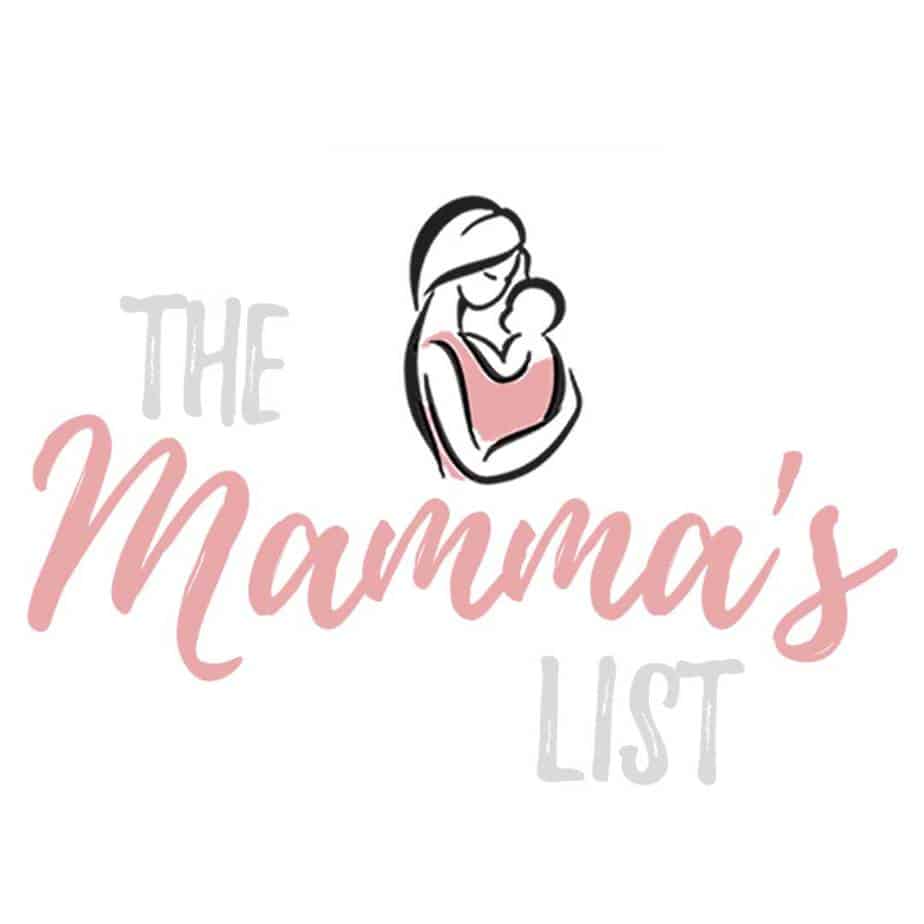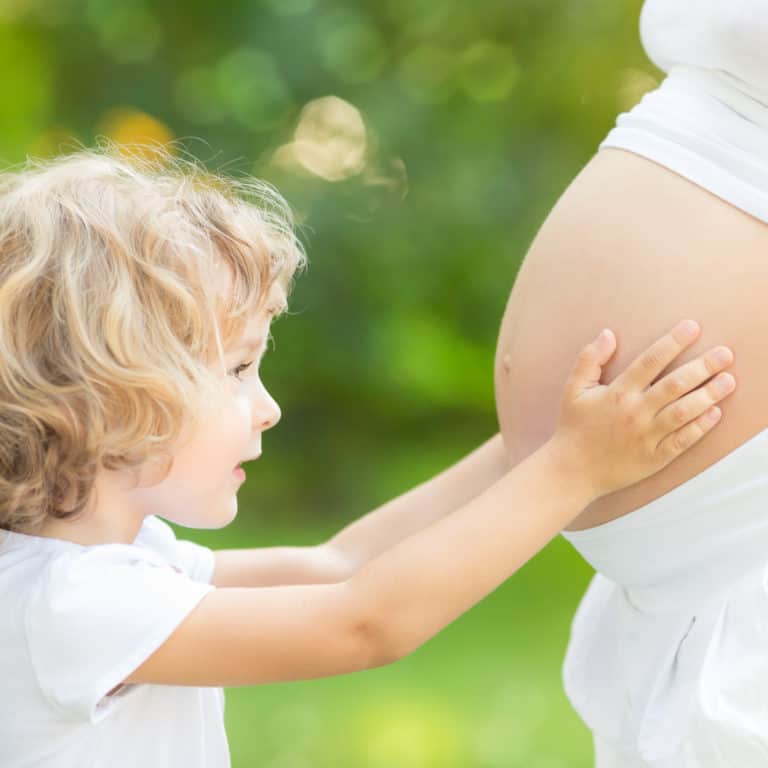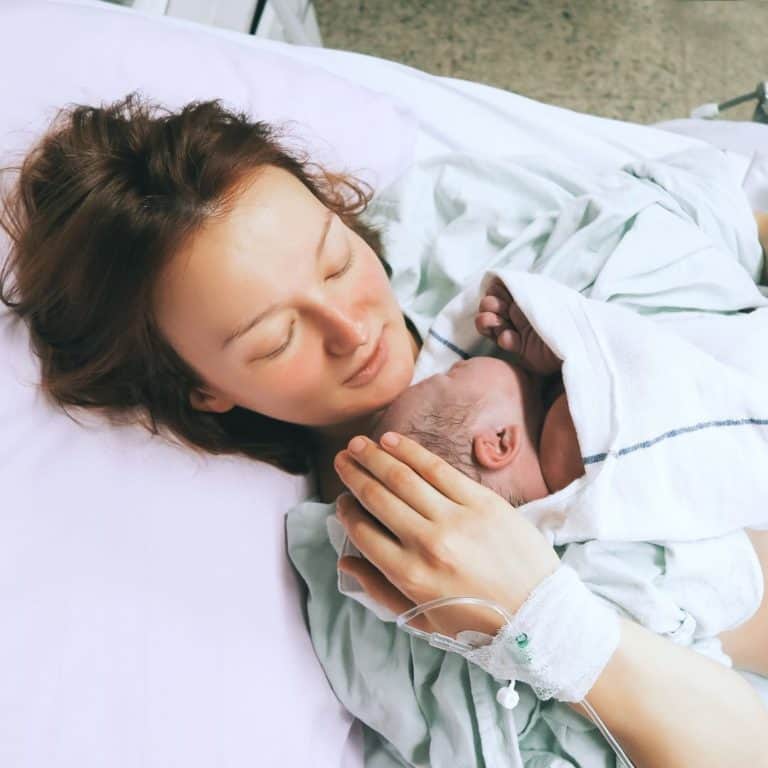The complete hospital bag checklist for labor (for mom, dad, and baby)
What you actually need in your hospital bag for labor, a complete printable checklist for the whole family
Making your hospital bag checklist and packing for labor may just be one of the most stressful things about finalizing your plans as a mom-to-be. There are about a million things running through your head and the last thing you want to do is forget that CRITICAL item you feel like you won’t survive without. The great news is, there really isn’t anything that crucial that you can forget.
The hospitals have everything you actually NEED to deliver your baby. But, I’m sure you’ll still be spending some time googling “what to pack in my hospital bag” or “labor hospital bag printable checklist.” It’s probably how you managed to get here! That said, I put together a comprehensive hospital bag checklist that will help any mom-to-be. You can download and customize your own copy, plus get a one-page birth plan template sent directly to your inbox.

This post probably contains affiliate links. That means if you buy something using one of my links I may receive a small commission – at no additional cost to you! It’s kind of boring, but feel free to read my full disclosure if you want more info
Can I overpack my hospital bag for labor?
The short answer is, yes.
The first thing to note here is that you aren’t going on a deluxe vacation. This is a (hopefully short) hospital stay and you don’t need to be dressed to the nines. Everything you bring in, you do have to bring out — along with a baby.
You should definitely bring things to keep yourself comfortable, but for all my chronic over-packers out there, keep in mind that the hospital rooms aren’t usually that large. A huge suitcase will just make you more uncomfortable in the long run.
To help keep your bags small, you can (and should) pack two separate bags.
Leave your hospital bag in the car while you’re laboring. This will keep your bag size down, will ensure you don’t ruin anything while laboring. You can then swap bags when you’re transferred to the maternity ward. Packing this way will generally keep everything neater.
{Note: check with your hospital around COVID restrictions. If you’ll only be in one room, no need to pack two bags.}
When to pack your hospital bag for labor
As I mentioned above, you might be bringing two small bags to the hospital if you’re changing rooms. Focus on getting your labor bag packed first. It happens fastest, so make sure you pack that one well in advance.
Aim to have it packed between 35-36 weeks. You can then pack a separate bag with items you’ll want with you for your hospital stay. I’d try to get them both done at least a month before you’re due, but your labor bag is most important.
Now, let’s break down what you’ll need in each bag.
What to pack in your hospital bag for labor: the complete printable checklist for mom
**A weird but important note here – don’t bring your Louis Vuitton luggage into the labor room. Not that I have Louis Vuitton luggage, but I wouldn’t bring it if I did.
There will be a separate space for things, and you will likely be able to put your luggage on a couch or some other high up area. But that’s not to say it’s 100% safe from a possible mess. Things happen quickly sometimes during labor and there are a lot of bodily fluids.
You don’t want to risk ruining your favorite luggage in the event something doesn’t go as planned. Also – if I got “fluids” from birth on my suitcase, I’d just let that puppy go. And I’d be REALLY upset if it was anything expensive!
Since you’ll need different things for labor and postpartum, only bring in the bag you need at first. You can swap in the car after the main event.
Many of the things you need in your labor bag are similar to what you’ll pack in the hospital bag, but you’ll want a separate set for after you’ve labored. Trust me on this one.
Hair tie
Trust me, you want this to hold your hair back, for reals. Don’t forget these.
Camera
The good one, and someone designated to take pictures if you want them.
Pain coping strategies
If you want anything to cope with the pain (music, tennis ball, or heated rice packs) don’t forget to put them in your labor bag. I wasn’t into any of that stuff, but if you’re planning for it, don’t forget to pack it.
Maternity/Nursing Bra
You might be braless but if you want a bra to hold up the ladies, no one will tell you to take it off.
Insurance Card/ID
Labor is an inopportune time to forget your ID or insurance card. Make sure they’re in your purse or wallet, and then don’t change that purse the month before you deliver.
Don’t forget to pack your birth plan in your labor bag
What exactly is a birth plan?
A birth plan is basically a set of general guidelines on how you would like your birth to go. Although you can’t really ever “plan” your birth – babies have a way of doing their own thing – it’s a great idea to have some thoughts on how you want the process to go.
For instance, if you want an unmedicated birth, you’ll want to let your nurses know that upfront so that you’re not offered an epidural every 15 minutes when the going gets tough.
If you really don’t want any interventions (like Pitocin or other medications for induction) this is also something you can put in your birth plan.
If you’re planning on cord blood banking that obviously needs to be thought through in advance, and if you’re doing delayed cord clamping you’ll want to tell them that as well.
{For those of you wondering, delayed cord clamping is basically allowing the umbilical cord to stop pulsating before cutting, at least 60-90 seconds after birth. Babies can get up to 50% more blood volume if you follow this practice.}
Of course, you can’t ever fully plan how labor is going to go and obviously you can’t determine whether you may need an emergency c-section, but you can add in that you want to labor naturally until it’s absolutely no longer an option.
It’s totally OK if your birth plan is “get the kid out safely.” There isn’t anything written anywhere that says you need a 12-page binder to take to the hospital.
Why should I create a birth plan?
It’s actually helpful to create a birth plan to start to educate yourself on ALL the different options and information out there. I was in the “I don’t want to know” camp with my first, and only afterward realized how uninformed I was about the entire process.
Creating a birth plan allows you to do some research and understand some of the options, as well as complications, that can occur during birth. It’s really hard to have an opinion or plan for something you’ve never heard of or thought about. In the middle of labor is a really bad time to start doing your learning.
Key benefits of having a birth plan
A birth plan also helps you have an open conversation with your birth partner or significant other.
Having an open conversation about how you want your birth to go opens the door to begin the conversation about other big decisions early. Discussing discipline, religion, sleep training, and other possibly contentious topics BEFORE your baby arrives is key.
Creating a birth plan with your partner also helps ensure he or she is informed in the event that you aren’t able to make clear decisions. Bringing your baby safely into the world is the first really big co-parenting event that you’ll do together. It makes sense to ensure you’re both on the same page for the big day.
A birth plan helps you communicate with your birth team
While a detailed 75-page three-ring binder may not be something your nurse or midwife wants to go through in the thick of labor, having your wishes written down can be really helpful as labor progresses. If you’re at the point where you just can’t answer questions or need some space, the birth plan can help. We opted to go with a doula for this reason. I wanted someone experienced in birth to help convey my wishes and help us make informed decisions in case things went awry.
You don’t need to get a doula to explain yourself, a good birth plan will always help. But, if you’re interested in whether a doula is right for you, feel free to check this out.
Related: What’s a birth doula, and why would you want one?
Your birth plan gives you a sense of control
In labor, there are a lot of things that are totally out of your control. You can’t control the outcome of how your baby is born, or whether you’ll need interventions you don’t want. But you can control your preparedness and communication with the team. Creating a birth plan can give you a sense of calm and control in a situation that is largely unknown.
Luckily, your birth plan doesn’t need to be complicated. You can use a simple one-page birth plan template to keep things easy.
Download your copy by entering your email below, and don’t forget to stick it in your labor bag once it’s done! Then keep reading to make sure you pack everything else you’ll need for the hospital.
Your hospital bag checklist for after delivery, for the entire family
Hospital Bag Essentials For Mom:
Shower toiletries and makeup
This tops the list for some reason on almost every “what to pack in your hospital bag checklist.” I’m guessing this is because people just feel better when they have their own stuff around. After going through birth, you’re going to want to feel as normal as possible.
There will be some hospital grade shower essentials in the hospital room, but I like specific hair product (hello curls) and want to feel as normal as I can after labor. I brought my own products and a small makeup bag so I at least know I won’t have frizzed out hair to deal with as well.
No – I don’t get dressed up to the nines since I don’t wear a lot of makeup anyway. However, if anyone is looking to get a few pictures I’d rather have the option of throwing on some concealer if I haven’t slept for days.
Here’s the list of essentials:
- Shampoo/conditioner
- Body wash
- Deodorant
- Toothpaste/toothbrush
- Facewash
- Face lotion
Chapstick
Enough said. This definitely needed its own spot on the list.
Tucks Pads & Dermoplast
I almost put these on the “optional” list because I believe most hospitals give them out, but since you’re going to need a supply for home anyway, go ahead and pack some in your bag.
These will really help with the healing process and they’ll be good to have on hand in case you’re waiting for more, or are just in a pinch. In case you don’t even know where to get this stuff, Amazon to the rescue!

A comfortable (and loose) going home outfit
Comfort is key here. You might be working around a c-section scar or very sore lady parts. Putting on tight-fitting or chafing clothing at this stage in the game just isn’t what the doctor ordered.
I think I actually wore a maxi dress home because I knew it would be super flowy and allow anything that needed to breathe some fresh air.
I’d say that jeans or anything super tight are an absolute no-no. Go with something loose-fitting or flowy, and just bring a coat if it’s winter!
Nursing Bra & Breast Pads
Most of the time you’ll either be topless or doing skin to skin in the hospital, it’s just a fact. However, for some of the larger chested mammas or those who just really need the support of a bra, you can bring your nursing bra with you to the hospital.
This is something they won’t provide, so if you want one, don’t forget to pack it. Typically your milk doesn’t come in until 3-5 days postpartum, but I was already leaking in the hospital with my first daughter.
I had no idea that I’d even have leaking problems, so I didn’t think to bring or use my breast pads. Since I’ve heard your milk can come in even earlier the second time, I’ll be bringing them this go around as well. These are the ones I use, and yes, I know I linked to the 100ct. Trust me, you’ll need them.
If you’re looking for reusable breast pads, I like bamboobies, but you can also try out this brand for free. Grab a free pair of reusable breast pads using the code TheMammasList35
These are really great and stretchy nursing bras that are awesome for immediately post-birth when you just want comfort. Grab some disposable nursing pads as well!
**NOTE: WASH the black bra before you sit anywhere. It dyed a pillow of mine before I’d washed it enough to get the dye out. They’re comfortable, and the price is right, but I knew we’d have to sacrifice somewhere.
I LOVE SIA maternity & Nursing Bras

{Buying Tip: If you can grab these for less than $28, you’re getting a steal}
Nipple Cream
They will likely give you this in the hospital as well, but if you have one you know you like (or just don’t want the old-fashioned lanolin) bring your own.

Boppy or My Breast Friend Nursing Pillows
I’d keep your nursing pillow in the car until you decide if you need it or not. We made due with the hospital pillows, and while not always ideal, at least you don’t have to worry about cleaning them.
I also am a complete germaphobe so I wanted to wash everything that came into the hospital with scalding hot water. This is difficult when you need to use the pillow every two hours.
That said, if you’re a first-time-mom and want to get lactation help with the props you’ll be using at home, it might be worth it to bring these into the hospital for guidance.

Robe or comfy PJs
If your own clothes make you feel more human, and you know you just want to get dressed after labor, be sure to pack a robe and nursing friendly PJS. I definitely brought my own clothes the first time but ended up living in the hospital gowns.
I know this sounds a bit strange, but I just want to give you a little heads up on why you might want to do this as well:
- The hospital gowns have great breastfeeding and baby access. I felt like I was topless most of the time anyway
- There is a lot of bleeding after birth, and I was disgustingly sweaty most of the time as my hormones shifted. I probably changed my gown 2-3x a day, and I definitely didn’t bring six pairs of PJS
- Potential for staining – remember the blood I mentioned? I wasn’t into the idea of soaking or ruining perfectly good PJS immediately after I got home from the hospital
If you’re going to have lots of guests I would suggest at least a robe for modesty, {here’s the one I have, and still wear all the time} but I only had close family and I really didn’t care to bring fancy pajamas.
These PJS are great for nursing, highly rated, and reasonably priced. They’re a great option if you’re looking for something for the hospital. Just make sure to get a dark color!
Shower Shoes
Rooms are cleaned after each patient, but I don’t shower in public places without shoes. And remember the fluids and germaphobia I mentioned? Those don’t stop in the shower.
For me, it was shower shoes or no shower. Is this 100% necessary – absolutely not. The floors are cleaned after every mom leaves. But, I wasn’t taking any chances. I have enough to worry about postpartum without catching some sort of rash from the shower. Here’s an option if you’re looking for a cheap pair of flip flops you can toss afterwards.
Slippers with grips
See above on the need to wear something on your feet. The grips are traditionally a hospital requirement, so definitely make sure you have something to wear that won’t allow you to fall.
I bought some cheap ones that I threw out after I got home. Again, no need to bring all those germs home with me!
Snacks!
Don’t forget to bring snacks for both you and dad. You’ll likely be hungry after labor or in between meals. It’s so much easier to have snacks on hand than to try and figure out what place will deliver at 4 a.m.
Long cell phone cord or portable charger
Your bed might not be near a free outlet, so getting a long cord or just using a portable or battery pack charger should do the trick.
Since this list can be comprehensive (even if you’re packing lightly) I put together a FREE hospital bag and baby prep checklist printable. Grab your copy and customize it if you want to add things to your list. It will come right to your inbox.

Optional things to pack in your hospital bag:
Pads
Let me be clear here – pads are not optional postpartum. Even if you have a c-section. BUT, bringing your own pads to the hospital definitely is optional. They will provide pads there. There will be a LOT of bleeding, and the mesh underwear from the hospital is also a lifesaver.
Some people just prefer the brand name pads they’re used to, and aren’t huge fans of the hospital-grade diaper like contraptions you’ll be wearing while you’re there. This is totally up to you. My vote is to use EVERYTHING at the hospital, and then take it all with you when you go home.
You’ll need a lot of pads and postpartum recovery items, and just a quick trip to the store isn’t gonna happen, so it’s better to stock up now.
Disposable Cooler
This one might sound a little bit strange, but if you’re planning to have your placenta encapsulated you definitely need to bring something to get it home. I wasn’t about to use our hard-sided food storage container, so we got a cheap disposable cooler specifically for placenta transport.
I read so many benefits about placenta encapsulation that we decided to try it. I’ve had both anxiety and depression in the past, so I wanted to do anything I could to ward off any postpartum issues. Although I didn’t escape the baby blues with my first, I wasn’t in full-blown postpartum depression.
Dad’s hospital bag checklist: what to pack in the hospital bag for your main man
Clothes for 2-3 days
Just in case. You never know how long you might get stuck there unintentionally.
Ipad or other electronics
Not that anyone has TOO much downtime in the hospital, but dad will want something to entertain himself, especially if there is other family around to help out.
Small toiletries kit
In most cases, dad will head home to shower and see any other siblings at some point, but you’ll want him to have a few essential toiletries like deodorant, toothpaste and anything else he uses daily to freshen up.
Pillow
You can bring one for yourself as well, but dad is more likely to need an extra than you are. Sometimes hubby ends up losing out on the hospital accommodations. And it’s not always guaranteed he’ll get an extra pillow.
Baby’s hospital bag checklist: what to pack in your hospital bag for baby
2-3 Outfits
The hospital will provide outfits for your little one to wear, but if you have anything specific you want for photos, don’t forget to pack it.
You’ll also need a going home outfit, and bring an extra just in case of an unexpected blowout!
A Packed Diaper Bag
A packed diaper bag looks different for everyone, but you’ll definitely want to include the following:
- Newborn Diapers
- Diaper Cream
- Receiving Blanket
- Swaddle Blanket (trust me, you can never have too many blankets when they’re this young – we love these)
- Wipes
- Extra clothes (at least 2 outfits)
Your Pediatrician’s contact information
Many pediatricians no longer make hospital visits, so your hospital pediatrician will need your pediatrician’s information to send over all the records and information. Bring their name and phone number or address so everything is set up correctly in the system.
Car Seat
This obviously won’t go in the bag, but you won’t be allowed to leave with your baby until you bring your car seat to the room. It’s a good practice to install the base (or car seat) around 36 weeks so you’re not scrambling when the big show hits.
? Hot deal: Don’t forget your carseat canopy. You can grab a free one here using the code TheMammasList50
Optional items for baby’s hospital bag:
Pacifier
You might want to bring your own pacifier. Many hospitals won’t offer pacifiers until breastfeeding is established. If you want to avoid this conundrum and know you’ll be using a pacifier, just bring your own.
Outfits for photos
You’ll definitely want to snap a few pictures in the hospital, but we just used our phones and the clothes she wore in the hospital. However, if you have a hospital photoshoot planned, don’t forget the adorable newborn outfits!
Related: Newborn Baby Essentials Checklist (plus printable)
I found the above list to be pretty comprehensive, without being overwhelming or feeling like I was packing for a two-week vacation in Europe. However, if you want to check out another list, Baby List has some good ideas as well.
I hope you found this post informative! Feel free to pin it or share it for later. Sharing is caring!

Related: How to fully get ready for a baby: your ultimate checklist of things to do before baby arrives
What you actually need in your hospital bag for labor, download the complete checklist for the whole family









